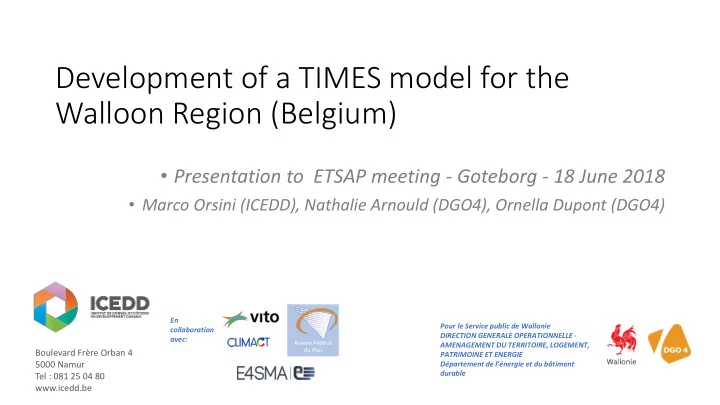

Development of a TIMES model for the Walloon Region (Belgium) • Presentation to ETSAP meeting - Goteborg - 18 June 2018 • Marco Orsini (ICEDD), Nathalie Arnould (DGO4), Ornella Dupont (DGO4) En Pour le Service public de Wallonie collaboration DIRECTION GENERALE OPERATIONNELLE - avec: Bureau Fédéral AMENAGEMENT DU TERRITOIRE, LOGEMENT, du Plan Boulevard Frère Orban 4 PATRIMOINE ET ENERGIE 5000 Namur Département de l’énergie et du bâtiment durable Tel : 081 25 04 80 www.icedd.be
Outline • Background > Regional competences and the relevance of a tool such as TIMES in the context of RW • Building up the model > challenges and opportunities of starting from (almost) scratch • The structure of the model > the art of compromise with the reality of data • Assumptions > Rational discussion is useful only when there is a significant base of shared assumptions (N. Chosky). • (Scenarios & ) Results > finally … • Next steps > once you start you cannot stop! 2
Background Population: 3,6 M Primary energy consumption: +- 170 TWh 3 Figure: https://fr.wikipedia.org/wiki/R%C3%A 9gion_wallonne
Background • The institutional setting > RW competences related to energy (and climate) > renewable energy production and energy efficiency • Need of a tool, transparent and flexible • To help political decisions (regional plan, measures choices , …) • To report on scenarios (with existing measures/with additional measures) No perfect model ETSAP opportunity => TIMES model 4
Building up the model • Building up the model > challenges and opportunities of starting from scratch • Not really from scratch > the Belgian TIMES model > not really fit to RW needs • Huge amount of data on energy > not always organised, consistent and coherent 5
The structure of the model • The structure of the model > the art of compromise with the reality of data • One region > which implies exogenous assumptions on imp/exp of electricity • 2050 Horizon • 24 times slices > optimisation « à la VITO » 6
The structure of the model • The structure of the model > the art of compromise with the reality of data • Reduced supply sector • Residential sector: 3 houses types + appart. / 5 age classes • Commercial sector: 5 subsectors • Transport sector: coherency (not fully yet) with COPERT RW • « Classic » electricity generation 7
Assumptions • Assumptions (in all scenarios) > Rational discussion is useful only when there is a significant base of shared assumptions (N. Chosky). • Phasing out of nuclear > as it is in the current legilsation (completed by 2025) • No import/export of electricity • No offshore wind energy • Constraints on: renewable potentials, renovation rates • Prices > mostly aligned with lastest EU and BE figures (e.g. fuels prices projections as in the BfP studies) 8
Results • (some surprising) Results: • Nuclear replaced by gas and wind, no PV, biomass (if existing subsides stay) • No need of further storage (in REF and EU2030 scenarios) • Heat pumps (for Commercial) and renovation of buildings (windows & roofs) > competitvness of these solutions 9
Results • Consumption of electricity (PJ) - REF 10
Results • Production of electricity (PJ) - REF avec subsides (CV) sans subsides (CV) 11
Lessons learnt • Opportunities > existing experiences (i.e. belgian TIMES model, ETSAP experts, …), but adaptation needed • Biggest challenge at this step > data collection > also an opportunity to centralise and challenge results of other studies ! • Economic optimisation > advantage and limit (some lack of realism => added constraint) • Tools > transparence and flexibility 12
Next steps • Next steps • Improvement of structure and data • Exploration possibility to use TIMES for reporting obligation (EU, UNFCCC) • Consultation of (external) stakeholders 13
Thank you for your attention! Marco Orsini (mo@icedd.be), Nathalie Arnould (nathalie.arnould@spw.wallonie.be), Ornella Dupont (ornella.dupont@spw.wallonie.be) Akwnoledgements Maurizio Gargiulo (E4SMA) - Jan Duerinck (VITO) – Dominique Gusbin & Danielle Devogelaar (Bureau Federal du Plan) – Laurent Noirhomme (Climact) En Pour le Service public de Wallonie collaboration DIRECTION GENERALE OPERATIONNELLE - avec: Bureau Fédéral AMENAGEMENT DU TERRITOIRE, LOGEMENT, du Plan Boulevard Frère Orban 4 PATRIMOINE ET ENERGIE 5000 Namur Département de l’énergie et du bâtiment durable Tel : 081 25 04 80 www.icedd.be
Recommend
More recommend